S/Sgt. John W. Zaucha

John W. Zaucha was born and lived in Jersey City, NJ at wartime. He was born Feb. 25, 1922. He was just 20 years old and of average height and weight (5’8″, 150 lbs.) when inducted into the army on Dec. 11, 1942. He worked at electrical maintenance before the war. He was single with no dependants.

Before receiving his notice to be shipped overseas, Zaucha received basic training, gunnery trains, and airplane mechanic instruction. He was promoted from Pvt. to Pfc., and finally to S/Sgt.
When Sgt. Zaucha arrived in the ETO. The 344th Bomb Group to which he was assigned had moved from Stansted, England to Cormeilles-en-Vexin. Located just six miles from Pontoise and 25 miles from France, the 344th was stationed at an airfield occupied by the Germans not long before. Most of the men lived in tents. Cold and mud were common annoyances. Still, the men found ways to enjoy their time between harrowing missions.
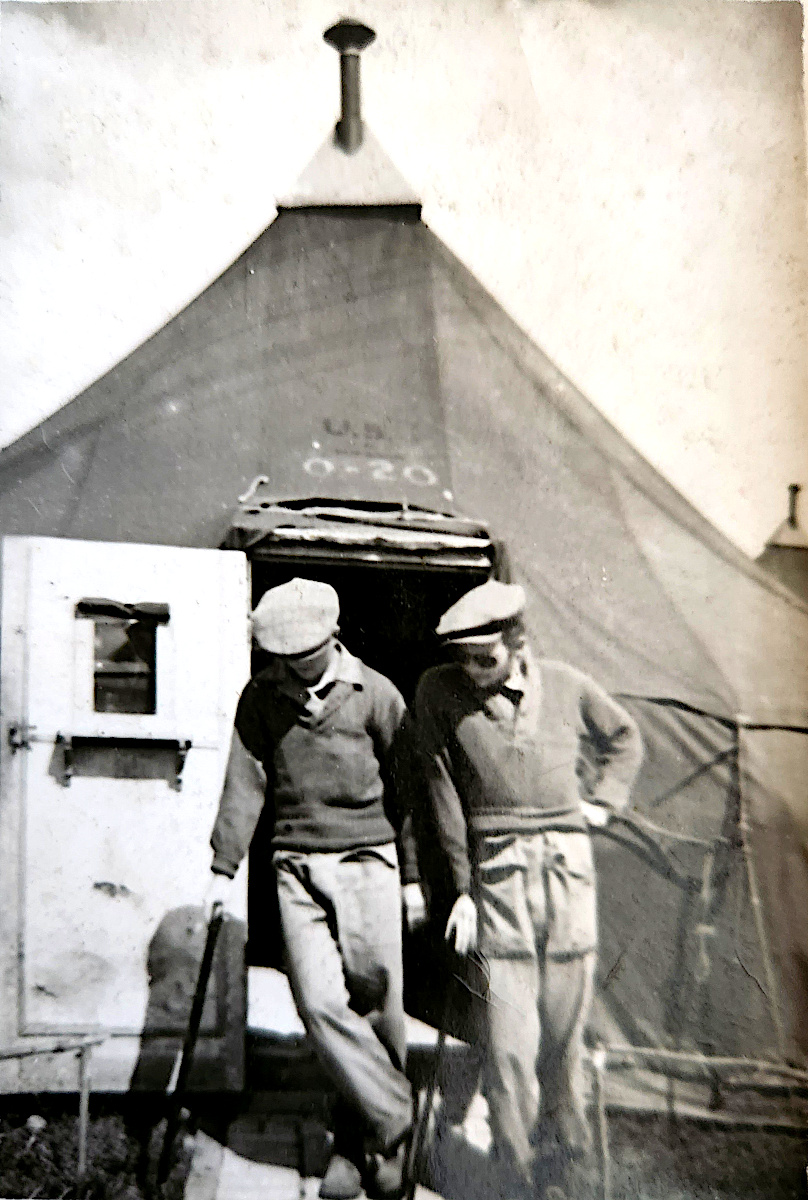

The 344th BG of which Zaucha was a member “adopted” an orphan Belgian child. Sgt. Zaucha kept an article about her.

According to the 344th History Book entitled Silver Streaks, “One day Sgt. George Friedman of the Intelligence Section came up with the idea of adopting a Belgium child from one of the orphanages and collecting the money to provide for his or her education. And thus was born the ‘Daddy Club.’
Sgt. Friedman selected a lovely ten year old girl who had lost her entire family in the Holocaust. Yvonne Sytner, who spoke English very well, proved to be as charming as she was lovely. The Red Cross girls attached to the base made her a uniform out of discarded shirts and trousers that they collected. Her cap was donated by a gunner who had the smallest head in the Group, and wore a donated a pair of WWI miniature captain bars. We gave a Daddy Card to everyone who donated to the fund, and we charged to have a picture taken with Yvonne.


Missions

If you look at the top margin of the right hand page above (Click to Enlarge), you will see that Sgt. Zaucha made a list of his mission dates. This was very helpful in finding the records shown below.
Sgt. John W. Zaucha’s earliest mission found upon a search of the records took place January 29, 1945. This took place during the Battle of the Bulge, also known as the Ardennes Offensive, it was the last major German offensive campaign on the Western Front during World War II. The battle lasted for five weeks from mid-December 1944 through January 1945.


According to the 344th History Book entitled Silver Streaks, “In the afternoon of January 29, a mission to Nonweiler, Germany Rail Bridge wound up the 344th’s activity for the month. Excellent results were scored. No damage or losses resulted from flak or fighter reaction.”

Zaucha flew in Y5-J, the “Shopworn Angel.” It was piloted by Shepherd in position 2-1-3.

According to the load list above, Sgt. Zaucha flew as an engineer/turret gunner along with 1st Lt. Shepherd, pilot; Rittscher, flight officer; Zibert, flight officer; Solodkin, radio/gunner; Watson, tail gunner. They flew in the Shopworn Angel (Y5-J) in position 2-1-3 of the formation. They took off at 1:45 pm and landed 5:45 pm after dropping their bombs as briefed. Probably, Shepherd who was an experienced pilot was “checking out” Rittscher to be pilot as that was his role thereafter.
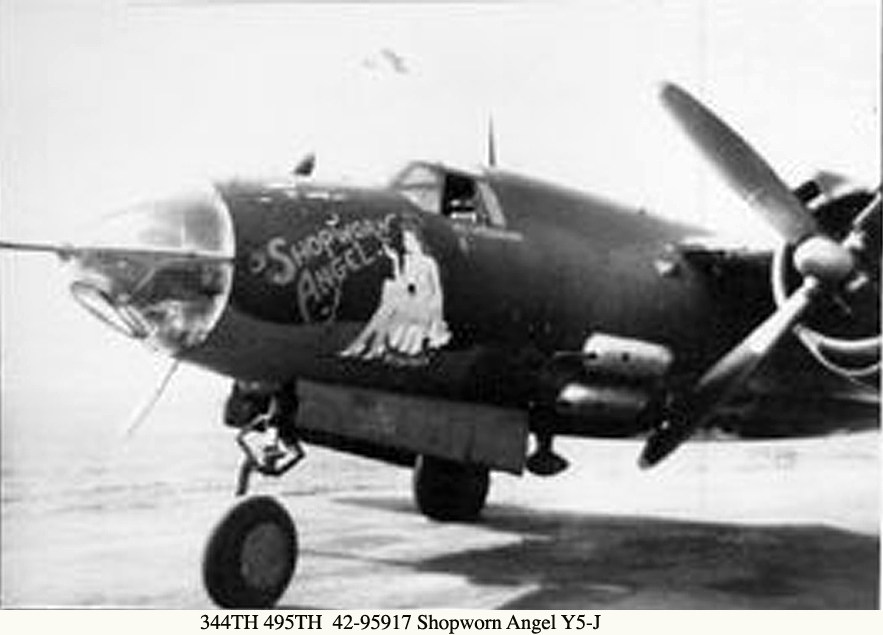
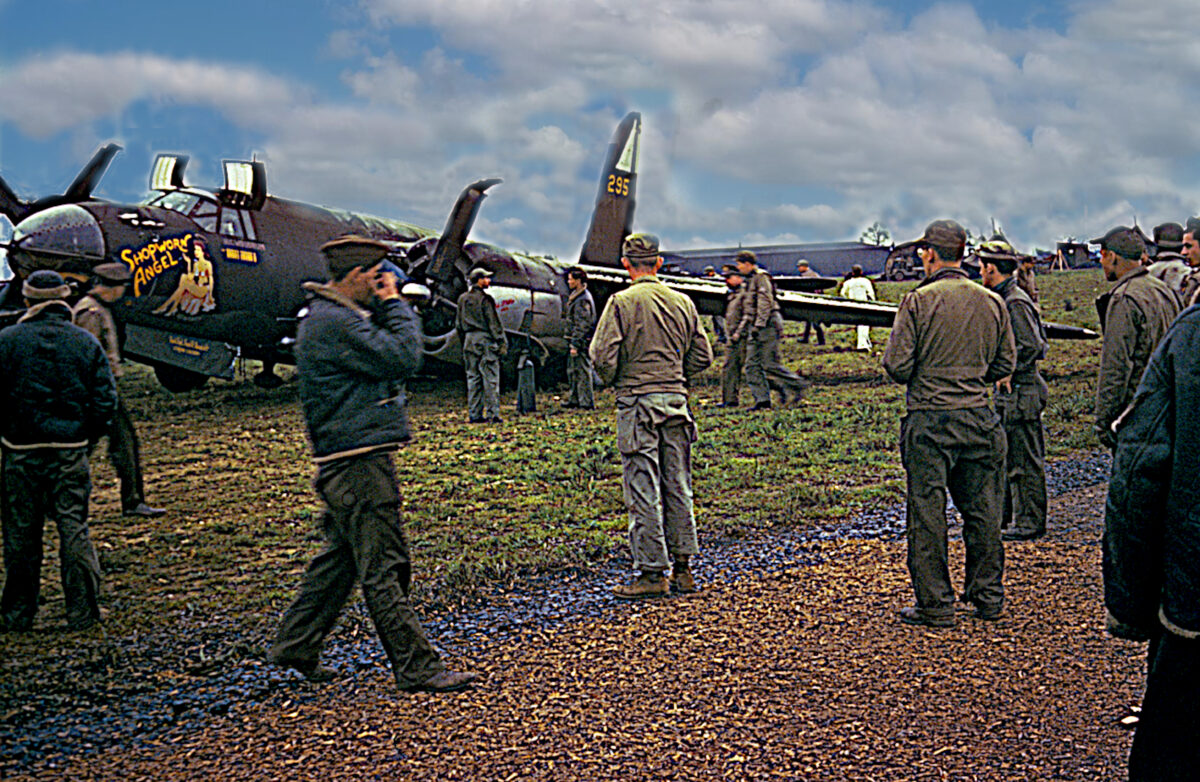

1st Lt. Shepherd indicated that they flew in Y5-J in position 2-1-3. Their pair of 2000lb bombs were dropped on the primary target at 3:45 from an altitude of 1,400 ft.

According to the 344th History Book entitled Silver Streaks, “On February 1, 1945 the RR bridge at Nassau and the defended town of Wittlich, Germany was to be bombed.”
“Sixteen planes attacked and their bombs missed the target; weather obscuring good sighting. No flak was encountered.”

Zaucha flew in Y5-L, the “Sexy Sal.” It was piloted by 1st Lt. Burns in position 1-1-5.


According to the load list , Sgt. Zaucha flew as an engineer/turret gunner along with 1st Lt. Burns, pilot; Rittscher, flight officer; Zibert, flight officer; Solodkin, tail/gunner; Watson, radio gunner. They flew in the Shopworn Angel (Y5-J) in position 1-3-5 of the formation. They took off at 12:43 pm and landed 4:45 pm after dropping their bombs as briefed.

!st Lt. Burns indicated that they flew in Y5-L in position 1-3-5. Their pair of 2000 lb bombs were dropped on the primary target at 2:10 from an altitude of 12,600 ft. The bomb salvo handle stuck causing one bomb to drop late.


According to the 344th History Book entitled Silver Streaks, “February 9, we bombed the Viersen Marshaling Yards with 35 Aircraft. Results were unobserved. Again, no flak was encountered.”

Zaucha flew in Y5-K, “Mary Mae.” It was piloted by Rittscher as a “window” ship. Flying “window” is a radar countermeasure in which aircraft spread a cloud of small, thin pieces of tinsel which either appears as a cluster of primary targets on radar screens or swamps the screen with multiple blips, in order to confuse and distract the radar of anti-aircraft gunners.
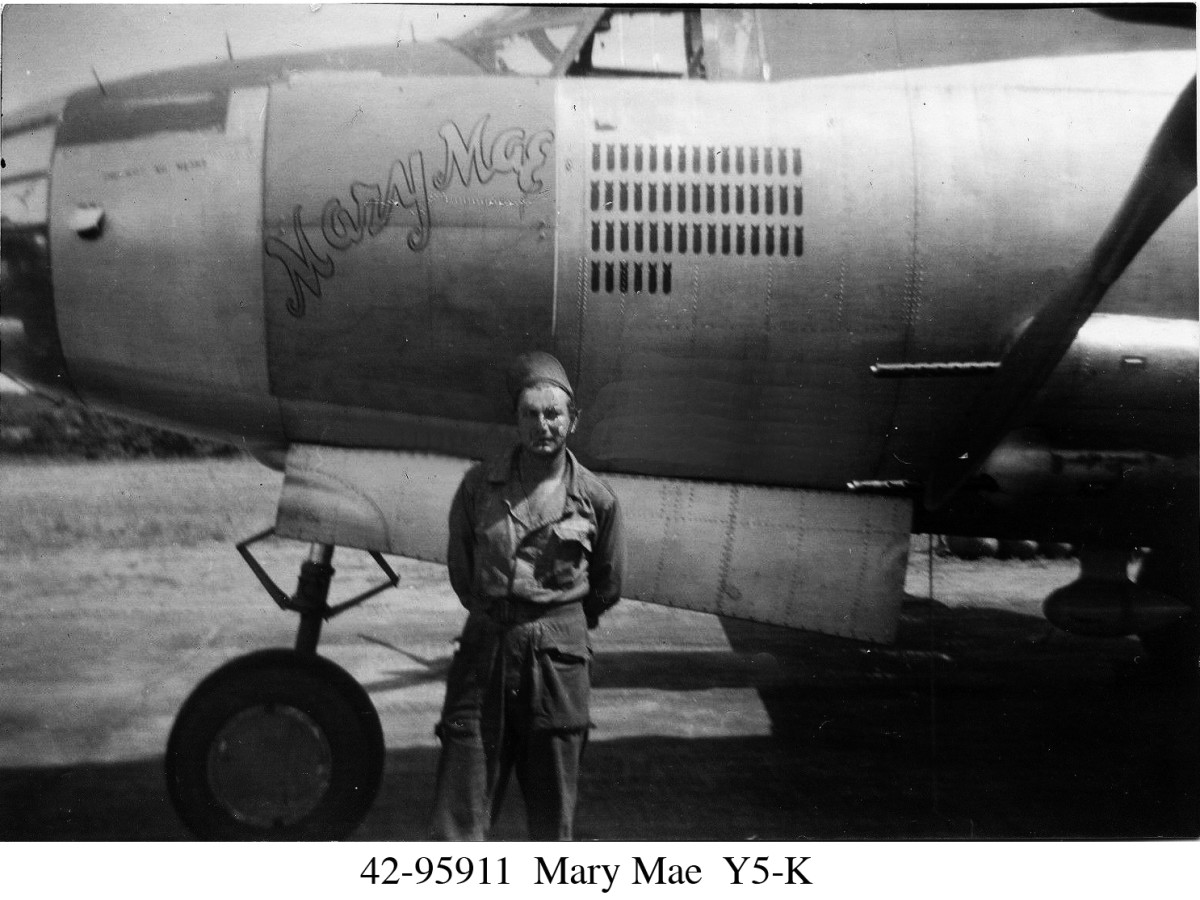

According to the load list, S/Sgt. Zaucha flew as an engineer/turret gunner along with 1st Lt. Rittscher, pilot; Tenoza, flight officer; Zibert, flight officer; Solodkin, tail/gunner; Watson, radio/gunner. They flew in 42-95911 Mary Mae (Y5-K) in a “window” position of the formation. They took off at 12:40 pm and landed 4:30 pm after dropping their “window” as briefed.

!st Lt. Rittscher indicated that they flew in Y5-K as a “window” ship.
According to the 344th History Book entitled Silver Streaks, “In the afternoon of February 14th the Railroad bridge at Engers was attacked. Seventeen (17) Aircraft dropped 34 tons of bombs with generally excellent results, though clouds and haze were rapidly obscuring the target from view. The attack being visually, by flights, on converging axis of attacks and the weather closing in did not allow all of the Aircraft to drop on the primary target. However, on the way out to Base, two (2) Aircraft bombed at Bullay on briefed secondary and four (4) on the Railroad bridge at Ellers, another briefed secondary target, while one plane bombed the town of Burenbach as a casual target. The attack on the Euskirchen bridge was met by severe and accurate enemy flak defenses, five of our Aircraft being shot down, 21 Aircraft damaged Category “A”, seven Category “B” and 31 of our personnel listed missing and six wounded. It was the first time since our attack on a bridge North of Paris that so many of our craft were lost in action and so many damaged.”
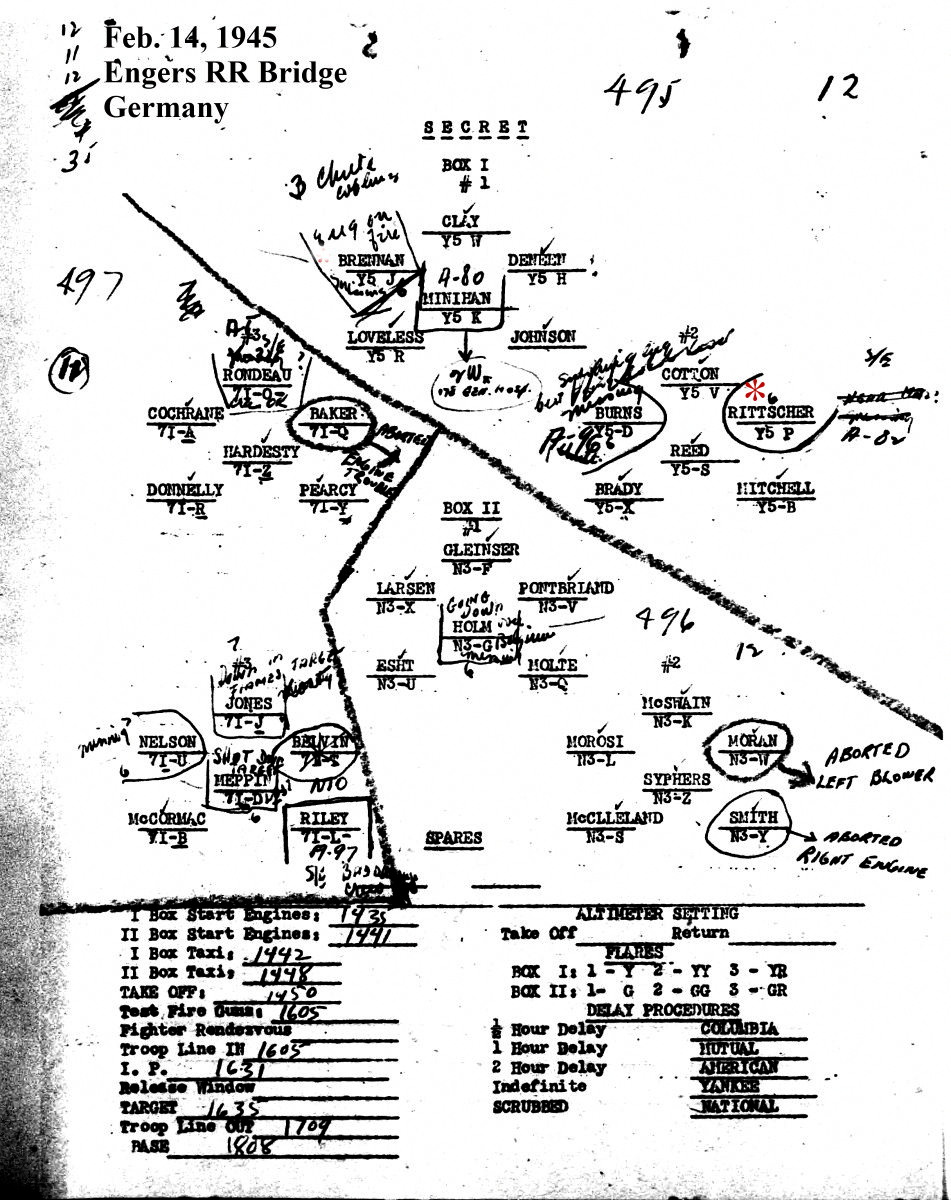
Sgt. Zaucha flew in Y5-L, the “Rosei O’Brady Y5-P” It was piloted by Rittscher in position 1-2-2.

“32 aircraft participated on a visual mission and bombed by flights. They encountered intense and accurate flak on the last 45 seconds of the bomb run and on the turn off from the target. The two ships destroyed were definitely seen to go down about the bomb release point. The status of the missing ships is as yet undetermined, but a total of six chutes were seen to come from three planes. One ship went down in flames; no chutes seen. “Window” was dropped, but effectiveness was very doubtful. Fire P.C. seen.”
Map symbols indicate two ships destroyed, three ships missing, Five landing at an alternative location (including Zaucha and crew), 22 ships with Cat. A damage and one with Cat. B damage.


According to the load list, Sgt. Zaucha flew as an engineer/turret gunner along with Rittscher, pilot; Tench, flight officer; Nutt, toggilier; Solodkin, tail/gunner; Watson, radio gunner. They flew in the Rosie O’Brady (Y5-P) in position 1-2-2 of the formation. They took off at 2:35 pm and landed did not return to base. Records show the plane and crew returned to fly missions subsequently.
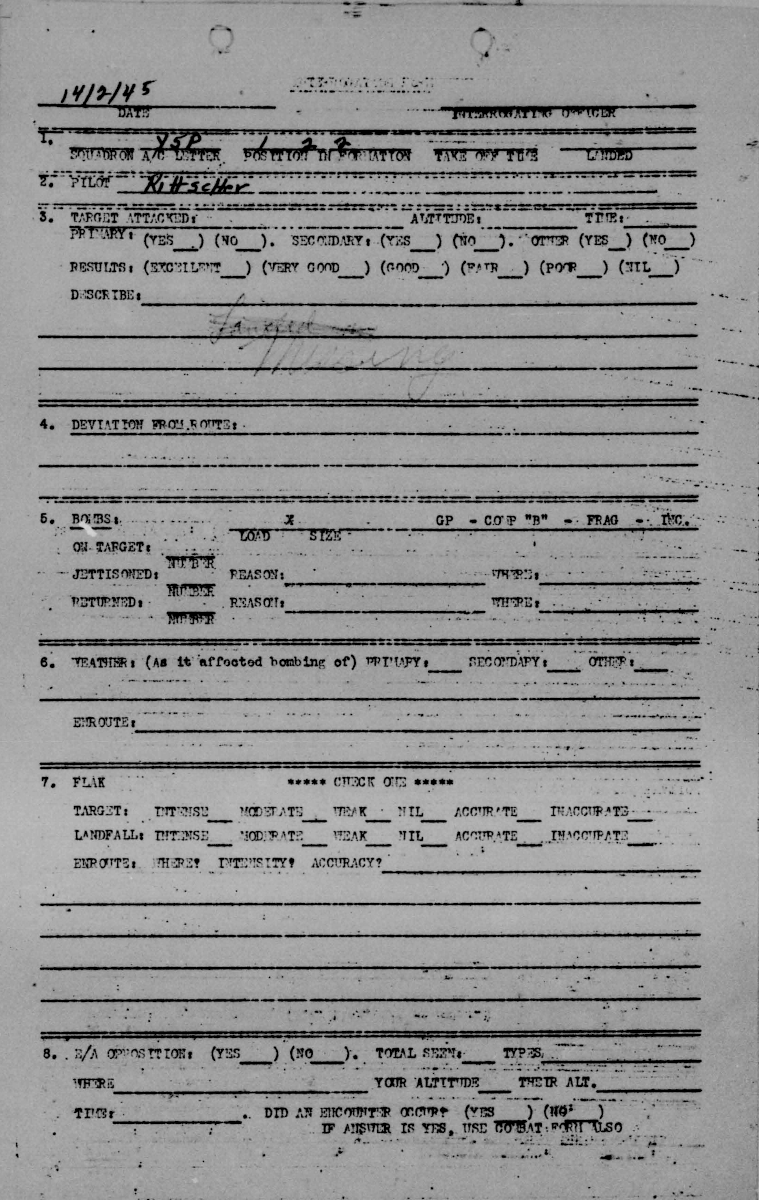
Filled in absentia as Rittscher was not able to return to base.
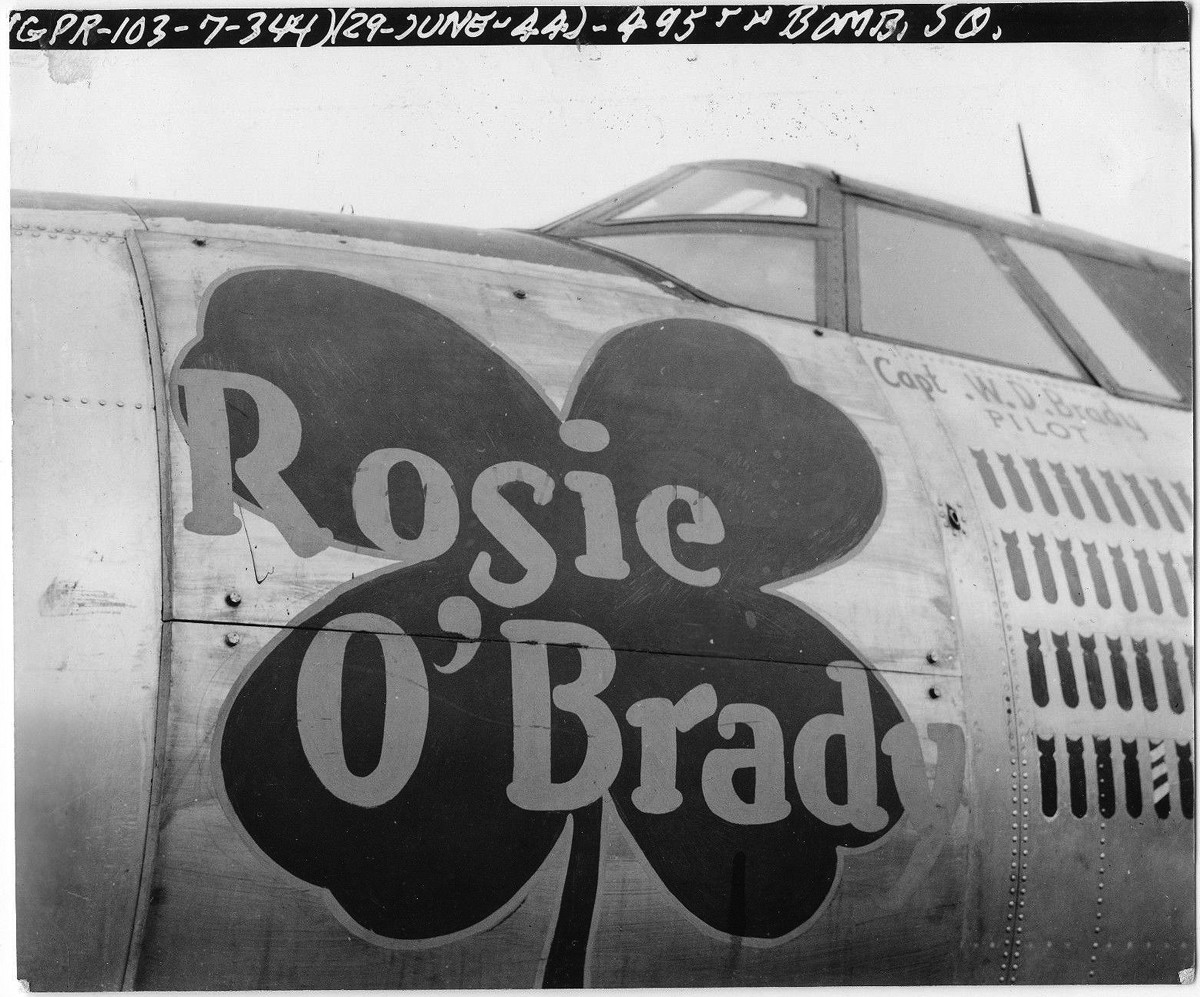

S/Sgt. Zaucha flew about 25 missions. The last was on April 25, 1945. This was the last mission of the war for the 344th Bomb Group as well. V.E. Day, the official end of the war in Europe was May 8, 1945.
Unfortunately, there was no load list in the records for that date. Since Zaucha flew with Rittscher the previous mission on April 19, 1945 and most of the previous missions I will reluctantly proceed that this was the case on April 25. Zach’s private notes indicate he indeed flew that day.
The 344th Bomb Group moved to a base in Florennes/Juzaine, Belgium on April 5, 1945.
According to the 344th History Book entitled Silver Streaks, “On the afternoon of April 11, the Marshaling Yards at Zwikau was bombed with excellent to superior results by 38 Aircraft, their 2,000-pound bombs ripping into sidings and buildings in the yards. One Aircraft piloted by Lt. Arnberg of the 494th Bomb Squadron left the target area on one engine and subsequently crash landed at Frankfurt-on-Main without injury to the crew. No flak was encountered.”

The formation diagram for 4/11/45 shows Rittscher, Zaucha and crew in position 2-3-6.


The map from April 11, 1945 indicates that Zacha’s box of planes flew at 8,250 ft and their time over target was 12:05 PM. “No flak experienced. Route flown as briefed with following exceptions. Flight 2 Box 1 made two runs on primary and one run on Eisleben. Flight 1 Box 2 made three runs on primary and one run on Ascherlrben. Flight 2 Box 2made three runs on primary and one on Eisleben.”
The visibility was 3/10.

According to the load list , S/Sgt. Zaucha flew as an engineer/turret gunner along with 1st Lt. Rittscher, pilot; Tenoza, co-pilot; Trevino, togiliere; Solodkin, tail/gunner; Watson, radio/gunner. They flew in 42-96045 (Y5-R) in the 2-3-6 position of the formation. They took off at 9:20 pm and landed 2:15 pm after dropping their bombs as briefed.
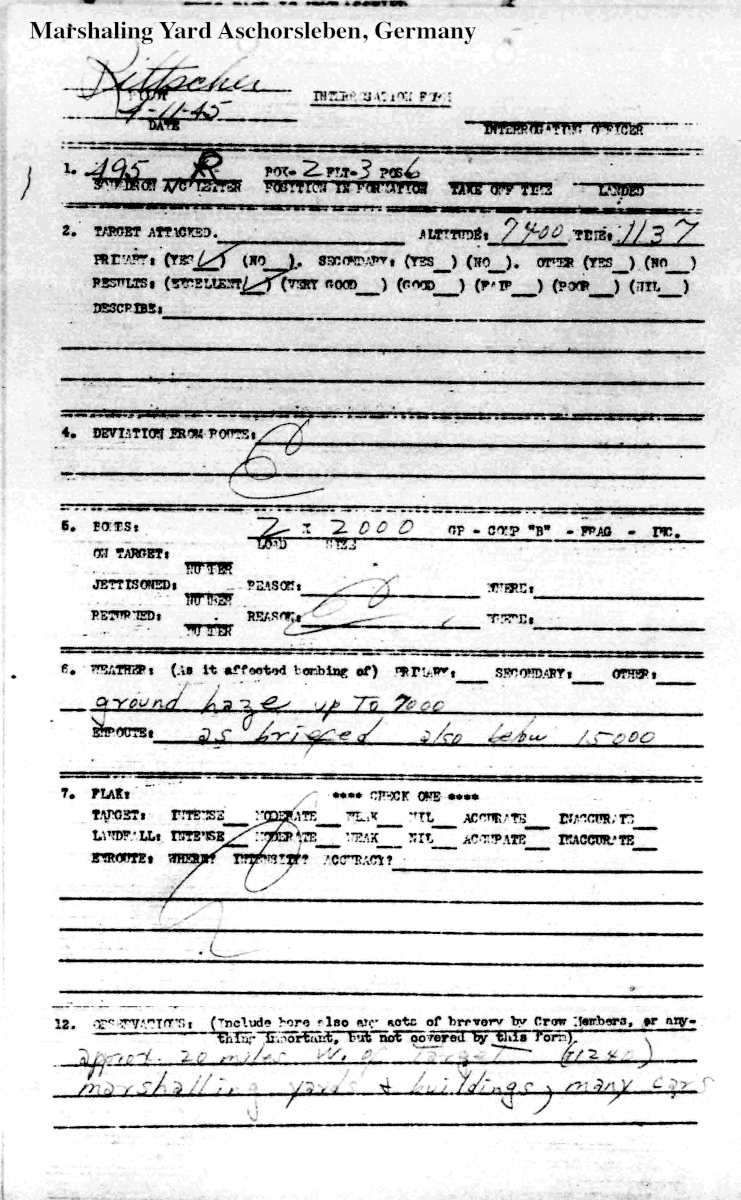
Rittscher indicates that he and crew of the 495th bomb squadron flew Y5-R in position 2-3-6 of the formation. They dropped 2 – 2000lb bombs from 7400 ft at 11:37 am. There was sound haze up to 7000 ft. Rittscher mentioned seeing marshaling yards, buildings and many cars approximately 20 miles West of the target.

According to the 344th History Book entitled Silver Streaks, “April 25 we bombed the Erding Airdrome with excellent results. 48 Aircraft participated, and no flak was encountered; however, the formation was again approached by ME-262 Jet Planes, but these enemy Aircraft did not attack. This was the last mission the Group flew against the enemy, though it was briefed on two more. April 26 the Group was recalled by the Fighter Control center as it proceeded to the Airfield at Plattling, and the Stodt Ammunition Dump lay on our briefing table from April 27 until the declaration of VE Day May 8, 1945.”
There is no load list available for 4/25/45 but since Zaucha had flown with Rittscher on the previous missions, I will reluctantly assume they also flew together for this mission. An informal mission list by Zaucha verifies that he flew this day.


Rittscher, Zaucha and crew flew in position 2-3-3 in Y5-R.


The target was an aerodrome in Erding. The second box flew over the target at 8950 ft at 5:46 pm. Visibility was 2/10 and 5-6 miles.

Rittscher indicates flying Y5-R in position 2-3-3. He also indicates that they dropped their 28 – 100 lb bombs on target as evidenced by observing burning aircraft below.

Escape Kit
The Army Air Corps provided airmen with kits to help them survive if shot down. Some items included were a booklet of common things to say in French. There were matches, rations, foreign money, tiny compass, a silk map that made no noise when opened, a small portrait in civilian clothes that the underground could use to make fake ID. There were other items as well, some depending on the location.

The picture above was included in S/Sgt. Zaucha’s evasion kit to be used to produce fake papers.

At the latter part of the war, the kit included a silk map of Holland, Belgium, France, and Germany.

Included with the items, saved by S/Sgt. Zaucha, from his evasion kit were these small compasses and a full sized version.
Flak Leave

Run by the American Red Cross, Southport was one of 16 country houses or ‘flak homes’ which housed airmen for Rest and Recuperation away from the stress of flying missions. Each serviceman was entitled to at least one rest period during their mission tour.
Southport was the largest of all of the Rest Homes and by the end of the war 15,000 men had passed through its doors.

Zaucha’s flak leave was from 5/17/45 – 5/27/45 in Southport, England.

Documents, Relics, and Memories

S/Sgt. John W. Zaucha earned quite an array of awards;
1&2. Presidential Unit Citation- Notice there are two!
3&7. Air Medal- Airmen in the 344th received the air medal for every five sorties over enemy territory. After receiving the first medal, successive awards took the form of an oak leaf cluster to be pinned to the ribbon of the original medal. Zaucha’s medal with 4 OLC represents 25 missions over enemy territory. Document 1 Document 2
4. American Campaign Medal- Awarded for service within the American Theater between Dec. 7, 1941 and March 2, 1946
5. WW2 Victory- Awarded for service between 7 December 1941 and 31 December 1946
6. Good Conduct (Enlisted man award only)- Awarded for exemplary behavior, efficiency, and fidelity in active Federal military service.
8. Europe Africa Middle East with 3 Campaigns- The medal was intended to recognize those military service members who had performed military duty in the European Theater (to include North Africa and the Middle East) during the years of the Second World War. The three stars indicate that Zaucha participated in three campaigns; Ardennes, Central Europe, and Rhineland.
9. Air Medal ribbon missing Medal
10. Aerial Gunner wings- The winged bullet on this badge represents the training and hazardous duty of aerial gunners who served on bomber aircraft such as the B-17, B-29, and the B-26 Marauder. Sgt. Zaucha manned the top turret which housed twin 50 caliber machine guns.

Finally, if you look at the very bottom of the awards display is a small piece of shrapnel. By the time John W. Zaucha entered the ETO, the Luftwaffe fighters were largely neutralized. The greatest peril was the shrapnel from the exploding shells of the German 88s. They were often radar guided. If they didn’t shoot down a plane, it would damage it enough to cause the plane to drop out of formation. Then the few enemy fighters left would pick them off. Also, many airmen were killed and wounded by the pieces of sharp metal passing through their plane.

Here are the dog tags that not only identified John W. Zauch, but covered his warrior’s heart. A little research makes it possible to figure out the information provided on the tags.
NARA – AAD – Display Partial Records – Electronic Army Serial Number Merged File, ca. 1938 – 1946 (Enlistment Records)
Line 1 is his name, even though the army got it wrong and used his middle name as his first name. His daughter had that corrected many years later.
Line 2 – 32598840 T43-44 O
Then a C under the O
32 in the front of the serial number indicates- 3 means draftee 2 means corps area two. Second Corps Area (New Jersey-Delaware-New York) HQ=Governors Island, N.Y.)
T43 is the year of his tetanus immunization shot which is an antibody intravenous shot
44 is the year he got toxoid tetanus shot not sure what that is… Seems it’s given when tetanus is eminent. A preemptive intra muscular shot (Kinda tells you they are expecting extra holes in you.)
O is blood type
C is Christian

When S/Sgt. Zaucha was separated from the service on Nov. 17, 1945 he was given this document that listed the roles he fulfilled and the skills he had gained; Basic Training, Duty Soldier III, Airplane and Engine Mechanic, Airplane Mechanic Gunner.
The last item is spelled out- Airplane Mechanic, Gunner 748: Assisted pilot in the operation of the aircraft by maintaining constant check on mechanical functioning. In combat acted as aerial gunner. Maintained and repaired aircraft equipment and parts whenever necessary.

This document certifies that S/Sgt. Zaucha returned to the U.S. on Nov. 4, 1945. The U.S.S. LeJeune transported him from Le Havre, France to New York. Note this was seven months after V.E. Day and Four months after V.J. day Aug. 14, 1945.


Nearly two weeks after arriving back in the states, John W. Zaucha received his honorable discharge dated Nov. 17, 1945.
A few highlights;
After victory in Europe, Zaucha was transferred to the 557 Bomb Squadron.
He was credited with participating in the Ardennes (Bulge), Central Europe and Rhineland campaigns for which he received three battle stars.
He served for two years 11 months and seven days.
Lapel button issued Sept. 2, 1945. This was known as the “Ruptured Duck.”

The “Ruptured Duck” is a Honorable Discharge Lapel patch originated in 1919 at the close of WWI. The purpose of the patch, and by WWII a pin, was to permit Honorably Discharged military personnel to wear their uniform for a period of time after they left military service due to their inability to afford civilian clothes, while at the same time identify themselves as no longer active duty personnel. The pin version of the patch was intended to permit civilian dressed, Honorable Discharged personnel to identify their former military status easily when applying for work or veteran’s benefits. Unofficially, it was also used as an identifier to railroad, bus, and other transportation companies who offered free or subsidized transportation to returning veterans.


An attempt was made to stay in touch with the crew. John Zaucha kept their addresses in his memorabilia box.




